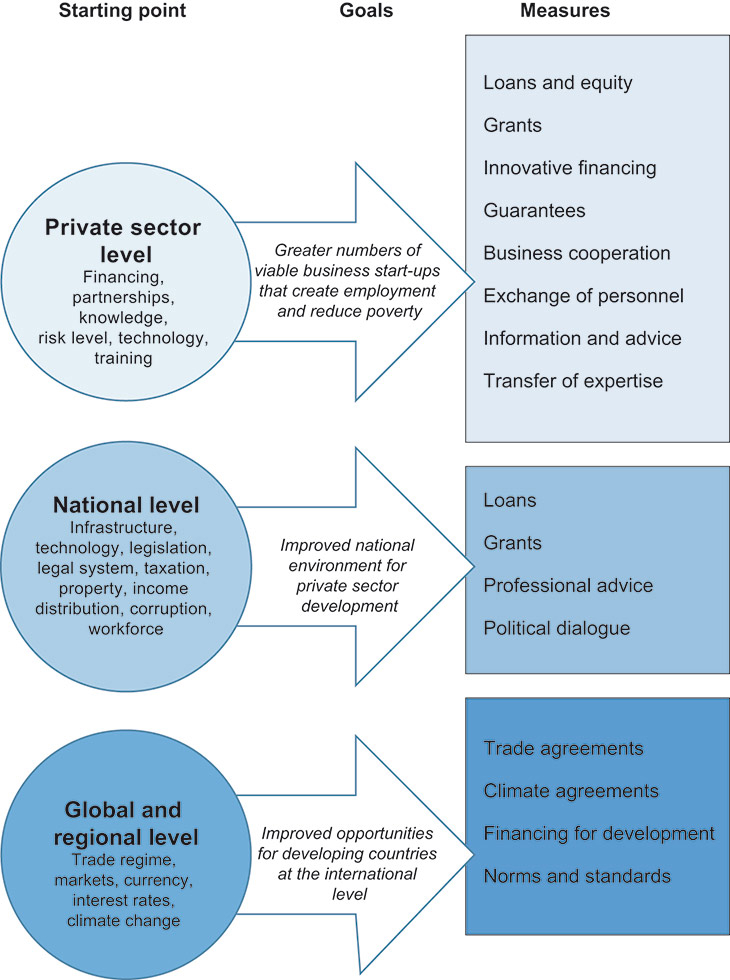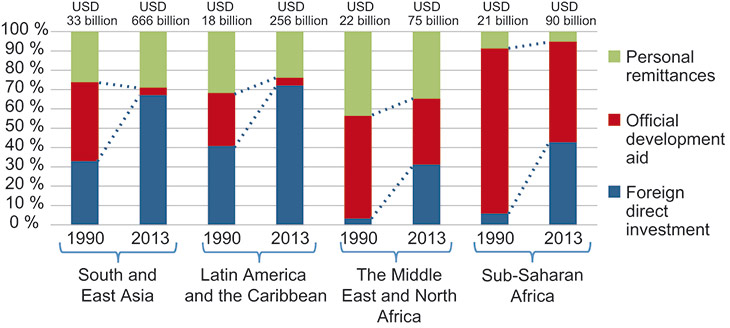1 Strengthened and strategically targeted support
The goal of Norwegian development policy is to contribute to democratisation and the realisation of human rights and to help people work their way out of poverty. Private sector development and sustainable economic growth are essential for achieving this goal. According to the World Bank, nothing drives poverty reduction as much as access to good, steady jobs and living wages. Increased workforce participation leads to better living conditions, economic growth, and higher levels of productivity and social integration. It helps people develop skills, strengthens the position of women, and has a stabilising effect on society as a whole.
Value creation in the private sector also generates tax revenues that can be used to fund improvements in infrastructure and services in areas such as health and education. This is highly significant for reducing aid dependency. The private sector is the main driver of development: nine out of ten jobs in developing countries are in the private sector.

Figure 1.1 India. A child plays with new technology while her mother works in the background.
Photo: Nitai Mondal
In this white paper, the Government sets out its intention to provide strengthened and strategically targeted support for private sector development in developing countries. The Government will tailor its efforts to meet the different needs and challenges of the recipient countries. In promoting private sector development, the Government will seek to strengthen its cooperation with the private sector and knowledge institutions, with particular emphasis on areas in which Norway has a competitive advantage. A substantial share of the support provided by Norway will still be channelled through multilateral institutions, funds and programmes. The white paper endorses the work to develop the new UN sustainable development goals and the international dialogue relating to Financing for Development; processes that take an integrated approach to achieving sustainable and lasting growth.
Figure 1.2 illustrates how Norway’s efforts are to have an impact at three levels: the private sector level, the national level and the global and regional level. It also shows what the goals for Norway’s efforts are, and what measures we will use. Although not all of the measures listed have private sector development in developing countries as an explicit goal, they can have positive development effects and help to reduce poverty through increased investments.

Figure 1.2 Strategic framework for Norway’s efforts to promote -private sector development
1.1 Effective aid as a catalyst
Today, aid is far less important for development in poor countries than it used to be, although there are great variations between regions and between countries in the same region. In recent decades there has been a significant increase in financing from other sources. In 1990, aid accounted for 63 % of all capital flows to low income countries and lower middle income countries. By 2013, this figure had been reduced to 21 %. This is a positive trend. The Norwegian private sector’s investments in developing countries have also increased substantially over the last decade. Today, many developing countries have a political goal of attracting increased investment and becoming independent of aid.

Figure 1.3 ODA levels, personal remittances and foreign direct investments, by region (1990 – 2013)
Source World Development Indicators (World Bank, 2014)
Support for private sector development is an important component of Norwegian aid. In 2014, Norway provided a total of NOK 3.6 billion to the most relevant sectors and areas for private sector development. 1
However, intensifying Norway’s efforts to promote private sector development is not just a matter of increasing the financial contribution. Deciding who we are to cooperate with, where and how is equally important. Aid should be used strategically to maximise the development impact. It should be used in situations where it can yield added value, i.e., bring about a result that would not have been possible without it. Used in the right way, aid can act as a catalyst, mobilising resources from other sources that would not otherwise have been made available.
One important strategic consideration concerns the choice of channels and partners in Norway’s development cooperation. What should Norway do bilaterally? And what can we do more effectively by working through multilateral institutions, funds and programmes? We must make good use of our own strengths where possible, while recognising others’ strengths in other situations.
In order to achieve maximum development impact, it is important that aid triggers other investments and initiatives. The Government therefore intends to intensify its cooperation with the private sector.
Creating an enabling environment for the private sector is one of the most important ways to promote private sector development. Much of Norway’s work in this area will therefore focus on this. Targeted efforts are needed to address the challenges involved, and the importance of an enabling environment should also be emphasised in the political dialogue. It is essential that the international community supports this effort and seeks to facilitate private sector development through concrete measures and an improved global environment for business. However, the authorities of the developing countries concerned have the main responsibility for solving the challenges at the national level, and are in the best position to do so.
Footnotes
This does not include the NOK 7.54 billion allocated for core funding to multilateral organisations in 2014, of which an unspecified amount was relevant for private sector development.